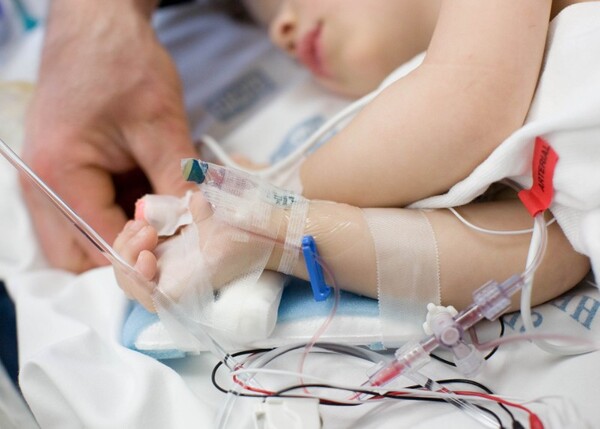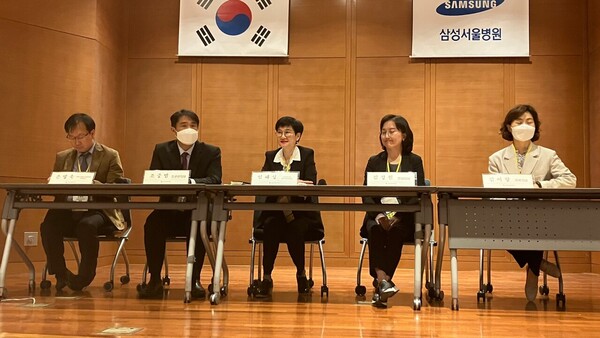Korea poses itself as a medically advanced country, but it is an “underdeveloped country when it comes to pediatric intensive care," a pediatric specialist said.
Experts point out that the reality facing Korea’s healthcare industry is disclosed by the mortality rate of patients hospitalized at pediatric intensive care units (PICUs). However, the fatality rate in Korea is twice higher as in the United States and Japan, with similar medical levels, which they attribute to a lack of system and infrastructure.

Professor Cho Chung-beom of the Department of Pediatrics and Adolescents at Samsung Medical Center said so at an academic conference on Saturday.
“It is difficult to treat young patients in the ward. There are no physicians to care for severely ill hospitalized children. The workforce shortage at PICUs at night and during weekends is very serious,” Cho said. “Some specialists have burnt out and carry a letter of resignation. This is a crisis.”
The professor noted that even after initial treatment in emergency rooms, these patients need continuous care by specialists, but few medical residents apply for pediatrics. He added that about 8,000 children are hospitalized at PICUs annually, but their fatality rate is more than twice higher than in the U.S.
According to the Health Insurance Review and Assessment Service (HIRA), Korea’s fatality rate at PICUs dropped from 5.5 percent in 2012 to 4.0 percent in 2018. However, it was two to three times higher than the corresponding rates of 2.29 percent in the U.S. in 2014, 1.1 percent in Finland in 2016, 2.6 percent in Japan in 2012, and 2.6 percent in Australia and New Zealand in 2016.
Lack of treatment infrastructure was cited as the reason Korea failed to narrow the wide gap in the mortality of severely ill children. Korea was “insufficient” in almost every way, such as the number of PICUs where children and adolescents can receive treatment and the workforce size.
For example, there are 13 PICUs nationwide – 11 in tertiary general hospitals and two in general hospitals. Such being the case, only 45 percent of the total severe pediatric patients are treated at PICUs, with the other 55 percent getting treatments at ICUs for adults due to lack of space.
The Korean hospital that runs the largest PICU with 25 beds has seven physicians – two regular specialists, two full-time doctors, and three medical residents. In comparison, a Japanese hospital with similar beds has 15 physicians exclusively responsible for it, over two times more than the Korean hospital.
“Many children die in PIVUs, but people do know that. That’s not because we are short of medical knowledge but because of the lack of a system,” Professor Cho said. “Korean children are living in an underdeveloped country in pediatrics. We should build a system to provide appropriate medical benefits for them but cannot do so.”

‘Severely ill children on edge of precipice have no place to go’
Most urgent is how to resolve the workforce shortage. The application rate for the pediatrics department itself has plunged. Moreover, Since the Medical Resident Act was implemented, specialists have been clogging holes without the infusion of fresh manpower at most hospitals.
“With the implementation of the Medical Resident Act, hospitals have made many efforts to keep their working hours. As a result, the workforce has dwindled to one-fifth level. Still, the workload of physicians increased as the severity of pediatric patients rose, and the quality of medical service improved,” said Professor Kim Kyung-won of the Pediatrics and Adolescent Department at Severance Hospital.
Kim disclosed that pediatric professors are coping with manpower shortage with all their might as hospitals fail to replenish the workforce.
“It’s been a year since I was on duty. I have run out of energy, and it took more and more time to recover after standing on duty. I don’t know until when I can do this work and whether it has any future,” Kim said. “Pediatric specialists have reached limitations physically and can no longer endure it with just a sense of mission.”
To replenish infrastructure to treat severe pediatric patients, the health authorities must include “PICU operation” in evaluating hospitals’ medical quality or designating them as tertiary general hospitals to improve the quality of PICU service, Kim emphasized.
“The pediatric intensive care is like a sinking ship. It has already sunken too deep for people aboard the ship to find a solution,” said Professor Kim Yeo-hyang, a pediatric at the Kyungbuk National University Chilgok Hospital. “Only a few left are holding out with a sense of duty and no new applicants.”
Government officials said they would supplement policies by reflecting difficulties in the fields on them.
“We have a heavy heart. Severe pediatric patients belong to essential care, so we have more interests and a heavier sense of duty in this area than others,” said Lim Hye-seong, director of the Overall Essential Healthcare Division at the Ministry of Health and Welfare.
“We have two policy directions. One is to provide incentives in reimbursement and other financial matters, and the other is including it in the evaluation criteria of hospitals,” Lim said. “We will make the most of these policy tools to replenish insufficient infrastructure for pediatric care. In addition, the government will communicate with the field to supplement policy shortcomings.”
Related articles
- Top pediatric cardiologist laments politics’ ill effects on medical sector
- President Yoon orders expansion of 24-hour pediatric emergency care system
- Seriously ill children start to receive home care support from AMC
- ‘CPR mortality in Korean children rose due to shortage of ICUs, pediatricians’
- PICUs vital for reducing mortality in critically ill children, yet facing shrinking numbers
- Wandering around ERs? Don’t blame doctors but change the system first.

